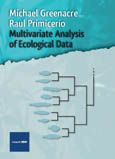Biological diversity is the product of the interaction between many species, be they marine, plant or animal life, and of the many limiting factors that characterize the environment in which the species live. Multivariate analysis uses relationships between variables to order the objects of study according to their collective properties, and to classify the objects of study, that is to group species or ecosystems in distinct classes each containing entities with similar properties. The ultimate objective is to relate the observed biological variation to the accompanying environmental characteristics.
Multivariate Analysis of Ecological Data is a comprehensive and structured explanation of how to analyse and interpret ecological data observed on many variables, both biological and environmental. After a general introduction to multivariate ecological data and statistical methodology, specific chapters focus on methods such as clustering, regression, biplots, multidimensional scaling, correspondence analysis (both simple and canonical) and log-ratio analysis, as well as issues of modelling and the inferential aspects of these methods.
The book includes a variety of applications to real data from ecological research, as well as two detailed case studies where the reader can appreciate the challenge for analysis, interpretation and communication when dealing with large studies and complex designs.
About the Authors
MICHAEL GREENACRE, Professor of Statistics at the Pompeu Fabra University in Barcelona and research collaborator with the BBVA Foundation, obtained his master degree in his country of birth, South Africa, and then his doctorate in Paris at the Pierre et Marie Curie University (Paris VI). He specialized in the visualization of multivariate data, principally in the social and environmental sciences, and spent sabbatical research periods at Rothamsted Experimental Station (UK); Bell Laboratories, University of Rochester and Stanford University (USA); the école des Mines (France); and the Norwegian Polar Environmental Centre (now the FRAM centre) in Tromsø (Norway). Besides co-editing several books on data visualization, he has written four books on correspondence analysis and related methods: for example, Biplots in Practice was published by the BBVA Foundation in 2010. He has produced over 80 publications, in major journals such as Applied Statistics and Ecology, including invited contributions to several encyclopedias.
RAUL PRIMICERIO, Associate Professor of Ecology, Evolutionary Biology and Epidemiology at the University of Tromsø, obtained his master degree in his country of birth, Italy, and later his doctorate in Norway. His research and teaching focus on quantitative biology, and he has been training graduate students and professionals at several research institutions in scientific method, statistical inference and modelling. He has coordinated ecological modelling activities at the High North Research Centre for Climate and the Environment (FRAM, Tromsø), and has collaborated and helped to coordinate several research projects on global environmental change impact funded by the Norwegian and European research councils. He has produced over 50 papers on both basic and applied issues, such as harvesting and climate change impact, including publications in the multidisciplinary journals Science and PNAS.

